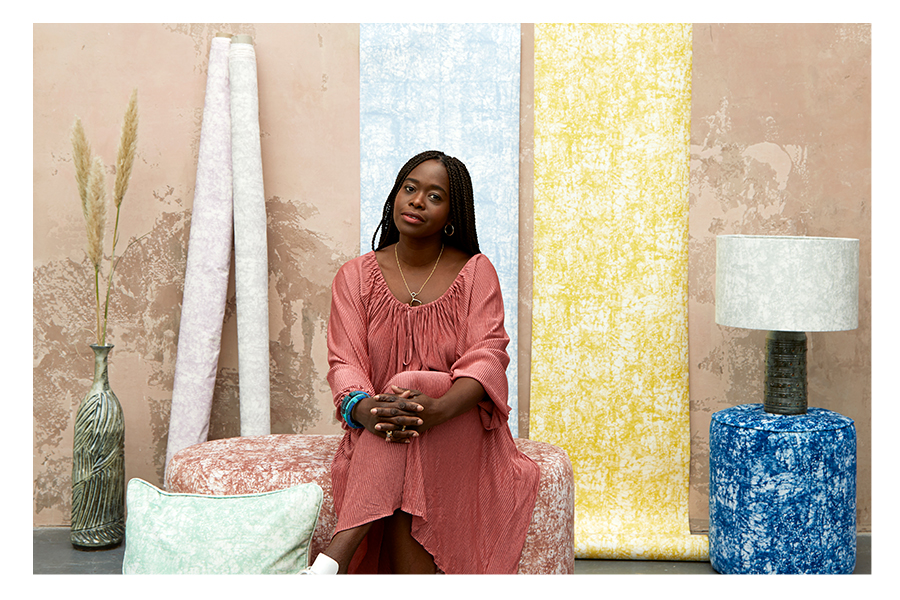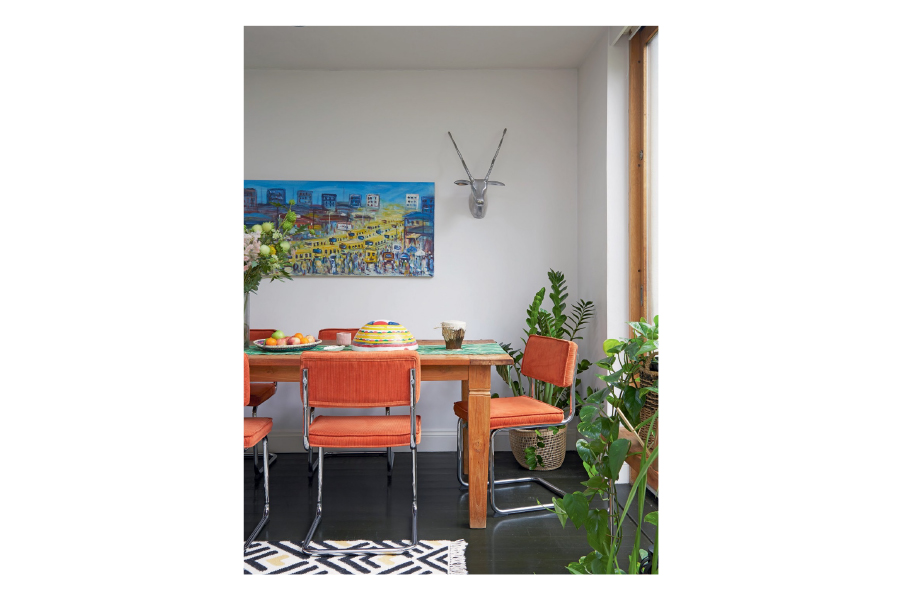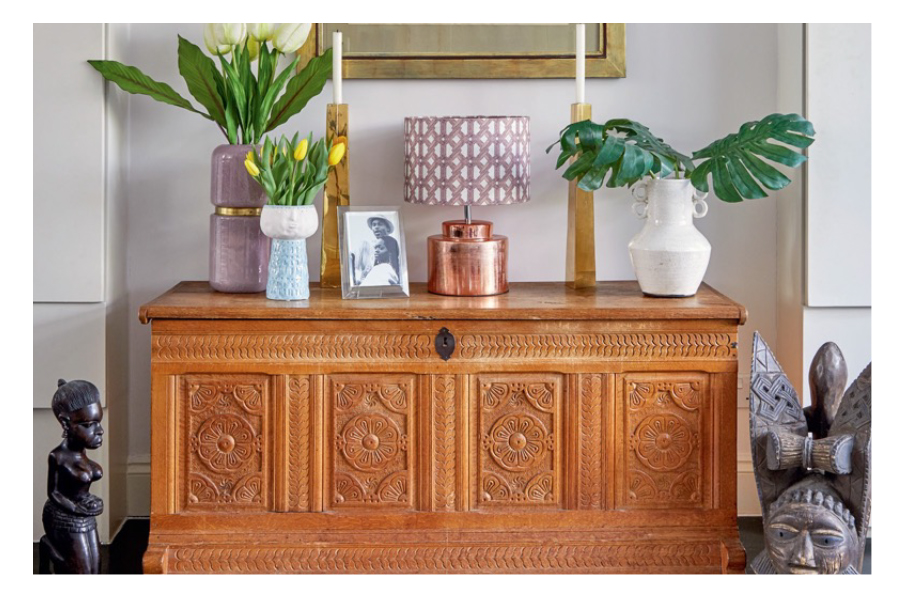With her unique take on contemporary African luxury, this textile and interior designer’s home is naturally filled with vibrant colour and bold prints.
Photography by Anna Stathaki

Eva is one of those enviable cross-discipline creatives with a fashion background that inspires her interiors career. She studied at the London College of Fashion where she specialised in contemporary African textiles before setting up her eponymous label in 2009. Eva Sonaike the brand offers luxury home textiles, soft furnishings, and an interior design service with an edge: a vibrant West African aesthetic runs throughout her designs, and it is disarmingly joyful.
She describes the exterior of her north London 1930s semi, which she shares with her husband and two teenage children, as “unspectacular”. But Tardis-like, it has been transformed into a bright and expansive family home. “Before we moved in, it was a typical two-floor, three-bedroom house, with a living and dining space on the ground floor,” she tells me. “But a light-filled space is crucial for me as it allows me to work effectively with colour and pattern.” The couple soon got to work on a huge rear extension that significantly increases the floor plan, as well as the ceiling height, cleverly.

“The unusual part of our living space is that we excavated two-thirds of the space and therefore have a sunken kitchen and dining space with high ceilings,” says Eva. “Best decision ever!” And with the addition of full height and width glass sliding doors that lead onto a levelled patio with an integrated mature tree, the extension ensures the family feel connected to nature at all times of the year, and whatever the weather. “We have a Lebanese cedar in the centre of the garden, which gives good shade in summer and is great in winter as it is evergreen,” she says. “We also have a large jasmine hedge, which has the most amazing aroma during the summer months.”
Each of Eva’s prints tells a story of its origin, from the architectural Alafia, inspired by the Hausa buildings in northern Nigeria’s largest city, Kano; to the bold, organic shapes of Wewe, which features banana leaf motifs taken from Ghana’s Aburi Botanical Gardens; and the arresting circular repeat pattern of Ayo – fittingly, Yoruba for joy. “The patterns I use in my textiles are my own interpretation of my West African Yoruba heritage and culture and with the stories each collection tells, I try to bring these stories to each and everyone who is interested in hearing them,” the designer tells me.

Of course, Eva’s home is filled with colour and pattern. Scatter cushions and pouffes in striking prints and bold hues bring the living room to life, while in the kitchen/diner, bright terracotta seating is met with a large, eye-catching geometric rug.Yet the property feels perfectly serene, and despite the loud colours, there’s tranquillity throughout. I wonder how the designer achieves this balance. “I have a very clear design style and always use a very simplistic concept of white walls and dark wooden flooring,” Eva explains. “This almost sets a blank canvas that allows me to use bold colours and patterns on the furnishings, soft furnishings, and accessories. And the colours look like they are mixed and matched, but the colour story in my home is carefully curated; something that comes naturally to me.”
Aside from the rich pickings of her own collections, I wonder where Eva shops for furniture and homeware. She tells me that she currently has a strict “no more shopping” policy in place for furnishing her home, and the restraint is admirable. But of course, there’s always the temptation of smaller must-have decorative pieces. “When I do shop for furniture, I love 1stDibs and Vinterior for one-off pieces, Sweetpea & Willow for furnishings, Amara for accessories, and I am obsessed with the Marché aux Puces in Paris for a more one-off item,” she offers. Where new meets old, there are some fascinating objets in the home, too, and naturally, these have a backstory. “My parents are great interior designers, so they kindly gifted me some of their furnishings and art from our house in Germany,” says Eva. “I also have some heirloom Yoruba statues and ornaments that are displayed in my home, and whenever I am in West Africa, I visit the local art galleries and craft markets for items or inspiration. On a recent trip to Lagos, I bought three threaded paintings from a local market and they have transformed my home – they are some of the most amazing statement pieces I have. They funnily match my sofa and the Kano cushion collection that is displayed on the sofa. I also love the large painting by Bolivian painter Graciela Rodo Boulanger that used to hang in my mother’s paediatric surgery. When she retired, I packed it up and took it on a plane to London.”

While Eva has created wholly inviting spaces throughout the property, the open-plan kitchen/ diner is undeniably the beating heart of this family home. And with summer just around the corner, she is looking forward to making full use of its indoor/outdoor design. “It is the perfect entertaining space,” she says, “and it was designed with having people sitting around our large teak wood table every weekend in mind. We usually eat on the kitchen island during the week, but come the weekend, we use the large table as a family and often have guests around to join us. And in summer, we can open the large sliding windows and it feels like alfresco dining.”
You’d be forgiven for leaving Eva’s home feeling as if someone’s turned down the colour saturation. Our immediate surroundings feel drab in comparison. But that’s the point, the designer would like to inspire us all to be a little bolder with colour and pattern – and it’s working. “The overall message,” she says, “is to bring more colour to the world and add a visual African narrative to the world of premium interior design.”
Eva’s home is also featured in House London by Ellie Stathaki and Anna Stathaki, published September 2022, £35 hardback (quarto.com)